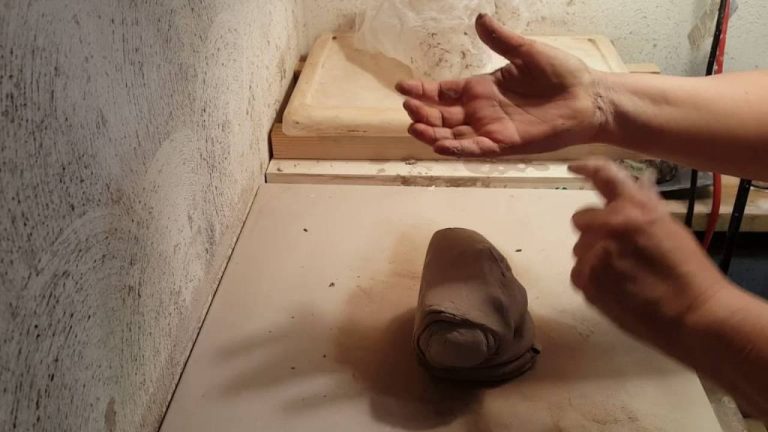How Do You Imprint On Clay?
Imprinting on clay involves pressing or rolling objects into soft clay to create patterns, textures, and designs. It is a versatile technique used by ceramic artists and potters to decorate and embellish clay creations before firing them in a kiln. Imprinting can be done using a variety of tools and objects, resulting in unique effects that would be difficult to achieve through other decorative methods.
There are many ways to imprint designs into clay. Some common techniques include using textured rolling pins, clay carving tools, found objects like leaves or lace, rubber stamps, molds, extruders, and more. The possibilities are endless when imprinting on clay. By experimenting with different tools and add-ons, ceramic artists can create one-of-a-kind pieces with beautiful embossed designs.
In this article, we will provide an overview of the imprinting process, including the tools and techniques used. We will also discuss finishing and curing imprinted clay pieces to ensure the designs remain visible after firing. With the right approach, imprinting allows ceramic artists to customize their works and take their creations to the next level.
Tools Needed
There are many tools that can be used to imprint designs and textures into clay. Some of the most common and useful tools include:
Clay Carving Tools
Clay carving tools like ribs, loop tools, shapers, and needles allow you to carve fine details and textures into clay. Rib tools have a flat edge that can smooth clay surfaces or imprint lines. Loop tools have a rounded end that makes curved impressions. Needle tools can incise fine lines and details.
Rubber Stamps
Rubber stamps with relief designs are an easy way to imprint patterns into clay. You can find ready-made stamps with different images and motifs, or have custom stamps made. Press the rubber stamp firmly into the clay to imprint the design.
Found Objects
Look around for interesting found objects to press into the clay like coins, buttons, seashells, leaves, or textured fabrics. Found objects add unique, custom designs and dimensions to stamped clay.
Textured Rolling Pins
Using textured rolling pins is a simple yet effective way to imprint designs onto clay. To use a textured rolling pin, you simply roll it over your clay slab or tile to press the texture into the surface.
Textured rolling pins come in a huge variety of patterns, from basic grids to intricate floral motifs. When rolled onto clay, these patterns get imprinted into the surface, creating an embossed look.
Pros:
- Quick and easy technique.
- Mass produce the same pattern across multiple clay pieces.
- Wide variety of textured designs available.
- Creates an embossed, professional finish.
Cons:
- Limited to the size of the rolling pin, usually 6-8 inches wide.
- Patterns can look repetitive if overused.
- Doesn’t allow for as much customization as hand carving.
Textured rolling pins are best for efficiently imprinting allover patterns onto clay jewelry, tiles, plaques, and sheets. The embossed texture adds artisan appeal with little effort required.
Clay Carving Tools
Clay carving tools come in a variety of shapes and sizes to create unique impressions in clay. These tools allow you to carve into the surface to make textures, lines, patterns and designs.
Some common clay carving tools include:
- Metal loop tools – Make smooth curved lines and impressions.
- Needle tools – For fine details and intricate patterns.
- Ribbon tools – Create delicate lines and texture.
- Fettling knives – Good for cutting, shaving and smoothing clay.
- Cutters – Make geometric shapes and cut outs.
When using clay carving tools, work slowly and carefully to get the design you want. Applying different amounts of pressure allows you to vary the depth and look of the impressions. Layering multiple tools together builds complex textures.
Always carve clay at the right consistency. If it’s too soft, details will get lost. Let your carved clay firm up before continuing to add finer details.
Get creative with the types of marks you make – try swirling loops, crossing lines, dots, geometric patterns etc. Combining carved textures with other techniques like rolling, molding and stamping adds visual interest.
Found Objects
Pressing found objects like coins, shells, leaves, and other natural items into clay can add unique textures and impressions. This is an easy way to make one-of-a-kind designs in clay. Start by gathering small found objects from around your home or yard like sea shells, leaves, seeds, pebbles, marbles, beads, bones, flowers, and anything with an interesting texture.
Next, roll out your clay to about 1/4 inch thickness on a flat work surface. Gently press your found objects into the clay, being careful not to push too far and pierce through the clay. You can press objects in partially or fully submerge them in the clay depending on the look you want.
Coins work particularly well when pressed fully into the clay, leaving a nice imprint. Leaves and flowers will leave behind vein and petal impressions when pressed in halfway or less. Play around with pressing objects in different orientations and patterns across the clay.
Once your found objects are pressed into the clay, gently remove them and allow the clay to firm up slightly before baking or firing according to the manufacturer’s instructions. The impressions left behind will add beautiful, natural textures!
Rubber Stamps
Custom rubber stamps can add beautiful, intricate details to clay projects. Stamps with elaborate patterns, textures, words, and images allow you to imprint designs quickly and consistently. When selecting rubber stamps, look for deeply etched stamps, which will leave crisper impressions in the clay. Laser cut rubber stamps capture fine lines and details especially well.
Always test your stamps on a practice piece first to ensure you get a clean impression. If lines appear broken or missing, try re-cutting the stamp. Ink the stamp evenly and thoroughly before each impression. Apply firm downward pressure straight onto the clay, rocking slightly to pick up the edges. Lift the stamp straight up to reveal the imprint.
You can stamp clay at any stage, but raw clay picks up finest details. For second impressions, carefully align your stamp over the previous imprint. Rotate stamps or combine different designs to cover larger areas. Clean stamps between colors so they don’t pick up clay residue. Let impressions fully dry before continuing to shape your clay.
Molds
Molds are a great way to imprint designs and patterns into clay. You can use existing molds or make your own custom molds. Here are some tips for using molds with clay:
Find or Make Molds
You can find a variety of ready-made molds at craft stores, online, or even around your home. Things like cookie cutters, jewelry molds, ice cube trays, and jar lids can make interesting designs. You can also make your own molds using silicone or plaster. Objects with interesting textures like lace, coins, or leaves can be pressed into silicone putty to create molds.
Prepare the Mold
Make sure your mold is free of dust and debris. You may want to lightly coat the mold with a release agent like cooking spray or petroleum jelly so the clay doesn’t stick. Allow any liquid release agents to fully dry before using the mold.
Press Clay into the Mold
Condition your clay by kneading until soft and pliable. Press the clay firmly into the mold, being sure to push it into all crevices and indentations. You may need to apply even pressure with your fingers.
Unmold the Clay
Let the clay sit in the mold for a few minutes until it holds its shape. Carefully remove the clay from the mold. You can use a soft clay tool to gently pry and lift the clay from the mold if needed. Allow any excess clay to dry before trimming away if unmolding proves difficult.
With some creativity and preparation, molds allow you to imprint and replicate almost any design into clay. Try layering multiple molded pieces to create unique effects.
Extruders
Extruders are a great tool for imprinting consistent patterns and shapes into clay. They typically consist of a chamber that you fill with clay, and a plunger you push down to extrude the clay out through a shaped disk at the end.
Extruders allow you to quickly imprint perfect shapes like bricks, coils, beads, lines, and more into your clay. You can find extruder kits with multiple disk shapes like circles, squares, rectangles, stars and more. Or you can make your own custom shaped disks to create unique imprinted patterns.
Using an extruder with a circle disk makes perfect round bead or dot patterns. A square or rectangle disk makes grid, brick, or tile patterns. Play around with mixing different shaped disks to createyour own signature imprinted designs in clay.
Extruders are very handy for quickly repeating patterns over and over, perfect for covering large areas evenly. They help streamline imprinting and decorating clay projects in a consistent and efficient way.
Decorative Additions
After imprinting designs into clay, you can further enhance the look by adding decorative elements. This allows you to create more visual interest and texture. Some ideas for decorative additions include:
Glazes
Apply glazes over imprinted clay before firing to add color and sheen. Glazes come in various finishes like glossy, satin, or matte. Use a consistent glaze or experiment with mixing colors and textures. Allow glazes to fully dry before firing.
Paints and Stains
Acrylic paints and ceramic stains can be used on air-dry or oven-bake clay. Paint over imprinted areas or in between design grooves. Allow paint to fully dry before continuing to work on the piece. Stains can add an antique or aged look.
Embellishments
Add dimensional details on top of imprinted clay like beads, buttons, charms, ribbons, lace, hemp cord, or found objects. Attach embellishments with liquid clay, strong glue, wire, or jump rings. Let any adhesives fully cure before handling.
Metallic Finishes
Try rubbing patina gels or metal leaf over imprinted clay to add a rich metallic finish. Let patinas fully dry and seal metal leaf with a protective coating.
Texture Medias
Coat imprinted clay with texture mediums like sand, rock candy crystals, mica powder, or glass beads. Apply a layer of liquid clay, press the medium into the surface, let dry, then brush off any excess.
Curing and Finishing
Allowing your imprinted clay pieces to cure properly is an important final step. Air drying imprinted clay overnight is typically sufficient for curing. You’ll know it’s cured when the surface feels dry and leather-hard.
Next, pieces can be sanded lightly if needed to smooth any rough edges. Apply a thin coating of sealant like polyurethane or acrylic varnish with a brush or foam applicator. This will seal the piece and add shine.
You may also choose to paint your imprinted clay pieces with acrylic paints and finish with a sealant coating. This allows you to add color while accentuating the imprinted design.
Finally, pieces can be displayed as-is or you may choose to add felt pads, hooks, or other hardware to hang your imprinted clay artwork.



